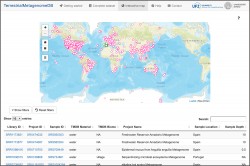Press Release, 05. February 2020
Helping discover the diversity in soil
UFZ researchers develop meta-database for terrestrial microorganisms
Microbiological communities, which include bacteria, single-celled organisms and nematodes, reveal a great deal of information about the state of soils. All around the world, a lot of research is being performed on this biodiversity at a genetic level but third parties are not always able to put these research results to the best possible use. The reason for this: The information recorded in databases varies in terms of quality. UFZ researchers have now built up a new metadata-database for terrestrial metagenomes with over 15,000 datasets, which is intended to make work easier for scientists. This was published in the scientific journal Nucleic Acids Research.
More than 202,000 metagenomes, i.e. the entire genetic information contained in a given soil sample, can be found in the two most important databases in which microbiologists can archive research data: the MG-Rast and Sequence Read Archive (SRA) repositories. Here, international researchers have recorded where they performed investigations into microbiological communities or genome sequencing on the seabed, in forests, in grassland or on rocks, and their findings. By doing so, they enable other researchers to use this data in their own research activities and compare it to their own findings. And it saves them from having to repeat time-consuming work on questions that may have already been answered. The researchers do, however, come across obstacles to their work time and time again: the datasets are often incomplete and not uniformly marked. "This makes it more difficult for interested users to further process the data," says Dr Ulisses Nunes da Rocha, microbiological ecologist at the UFZ and one of the study’s lead authors. This starts with minor details, such as the temperature. Temperature can be recorded in different ways using Fahrenheit, Kelvin or Celsius; the way in which the units are abbreviated varies in addition. But there is also uncertainty with regard to what may seem to be basic issues; for example, some scientists around the world have different understandings of the exact definition of a biome (the scientific term for a large-scale habitat). All this, says Dr da Rocha, makes it more difficult to use the data efficiently.
Dr Ulisses Nunes da Rocha and his team have now filtered the metagenome data out of the MG Rast and SRA datasets collected by researchers in the terrestrial environment around the world. In contrast, they screened out data collected from the seas and oceans. Exactly 15,022 metagenome datasets from forests or grasslands or from the subsoil originating in 84 countries were brought together in the new metadata-database. They did not develop any new scientific standards for the exact description of this metadata, such as the geographical coordinates, the pH value or the temperatures involved but used an existing method of standardisation. "The metadata-database helps researchers whose work centres on the terrestrial environment and who want to incorporate data of this kind into their own work," says the UFZ researcher. Instead of performing complex laboratory experiments for the purpose of CO2 fixation or establishing the effect of pesticides on microbiological communities, to name two examples, researchers can consult the database to see if researchers somewhere around the world have already performed similar experiments on this topic and have made their data available.
The UFZ’s freely accessible "TerrestrialMetagenomeDB" metadata-database went online at the beginning of November. Users can initially use six filters, such as the origin of the biome, sample type or the data source to search the database and, if necessary, track down more specific data by means of a further 33 filters. Secondly, another approach provides an interactive map of the world that users can use to look for datasets according to geographical features. Three video tutorials offer additional user support on how to best conduct research and download the data. The metadata-database is automatically updated twice a year - in January and July. As part of this process, new or corrected datasets are automatically retrieved from the MG-Rast and SRA repositories, assuming that groups of scientists have adapted the attributes of their own data to the standards of the new database. There is great potential: there are another 100,000 or so datasets on hold containing data on terrestrial metagenomes that could not be standardised to date because the data had not been entered precisely enough. For Dr Ulisses Nunes da Rocha and his UFZ "Microbiological Systems Data Science" working group, this is only the first step in a process of facilitating big data analyses of microbiological communities in terrestrial systems on a global scale.
Publication:
Corrêa, F. B., Saraiva, J. P., Stadler, P. F. & da Rocha, U. N. (2019). TerrestrialMetagenomeDB: a public repository of curated and standardized metadata for terrestrial metagenomes. Nucleic Acids Research, https://doi.org/10.1093/nar/gkz994
The database can be found at https://webapp.ufz.de/tmdb/
Further information
Dr. Ulisses Nunes da Rocha
UFZ Department of Environmental Microbiology
ulisses.rocha@ufz.de
UFZ press office
Susanne Hufe
Phone: +49 341 6025-1630
presse@ufz.de
In the Helmholtz Centre for Environmental Research (UFZ), scientists conduct research into the causes and consequences of far-reaching environmental changes. Their areas of study cover water resources, ecosystems of the future, environmental technologies and biotechnologies, the effects of chemicals in the environment, modelling and social-scientific issues. The UFZ employs more than 1,100 staff at its sites in Leipzig, Halle and Magdeburg. It is funded by the Federal Government, Saxony and Saxony-Anhalt.
www.ufz.deThe Helmholtz Association contributes to solving major challenges facing society, science and the economy with top scientific achievements in six research fields: Energy; Earth and Environment; Health; Key Technologies; Matter; and Aeronautics, Space and Transport. With some 39,000 employees in 19 research centres, the Helmholtz Association is Germany’s largest scientific organisation.
www.helmholtz.de
